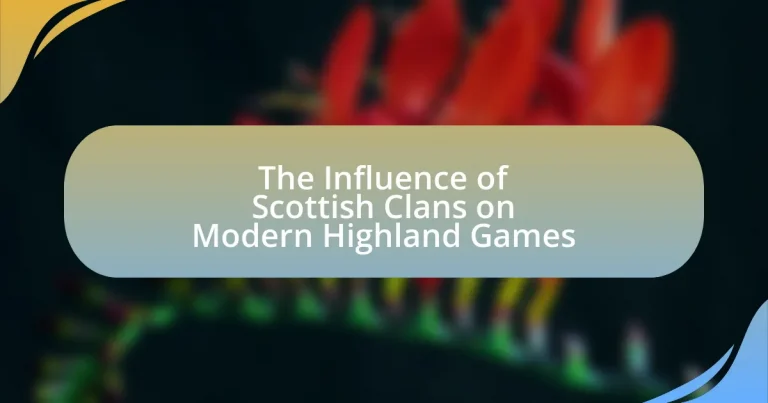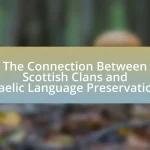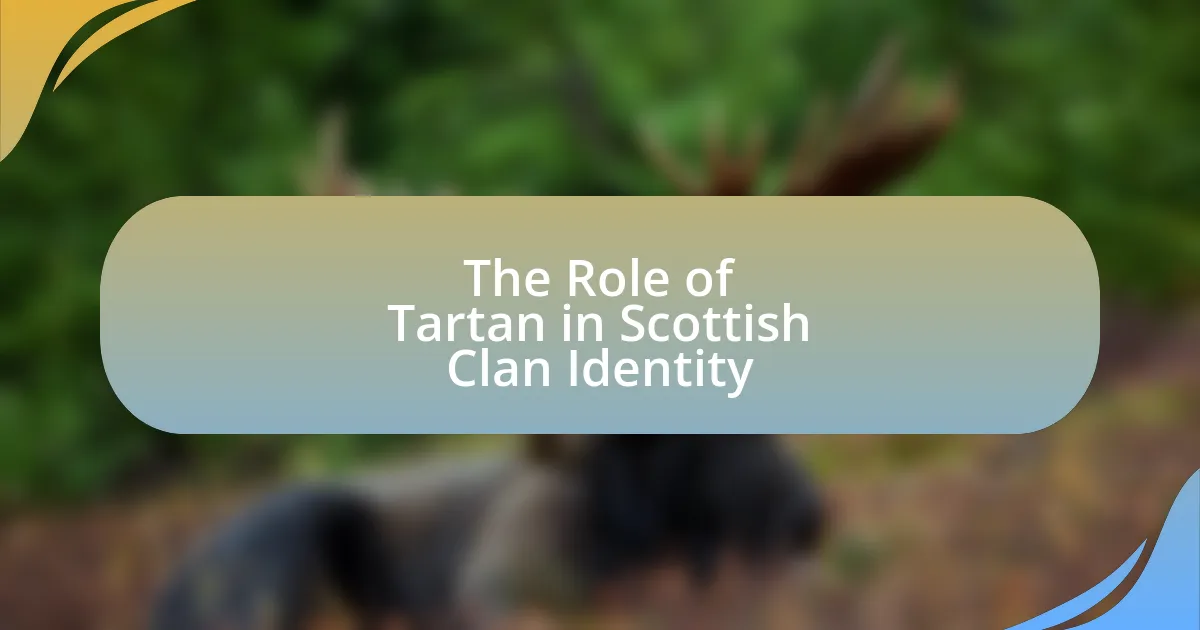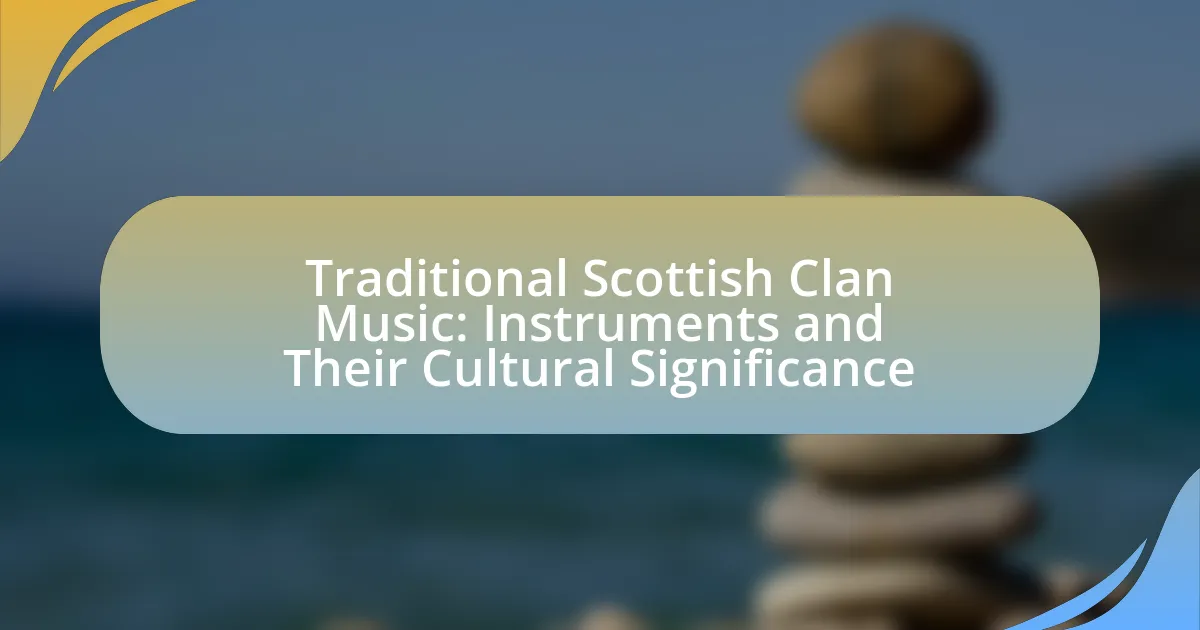Scottish clans are social groups that historically represented extended families and kinship networks in Scotland, playing a significant role in the country’s history and culture. This article explores the formation, evolution, and historical significance of Scottish clans, particularly their influence on the Highland Games. It examines how clan rivalries shaped Scottish history, the cultural practices associated with clans, and their ongoing impact on modern Highland Games events. Additionally, the article discusses the ways clans engage with contemporary society, adapt to modern trends, and enhance their involvement in promoting Scottish heritage through these traditional athletic competitions.
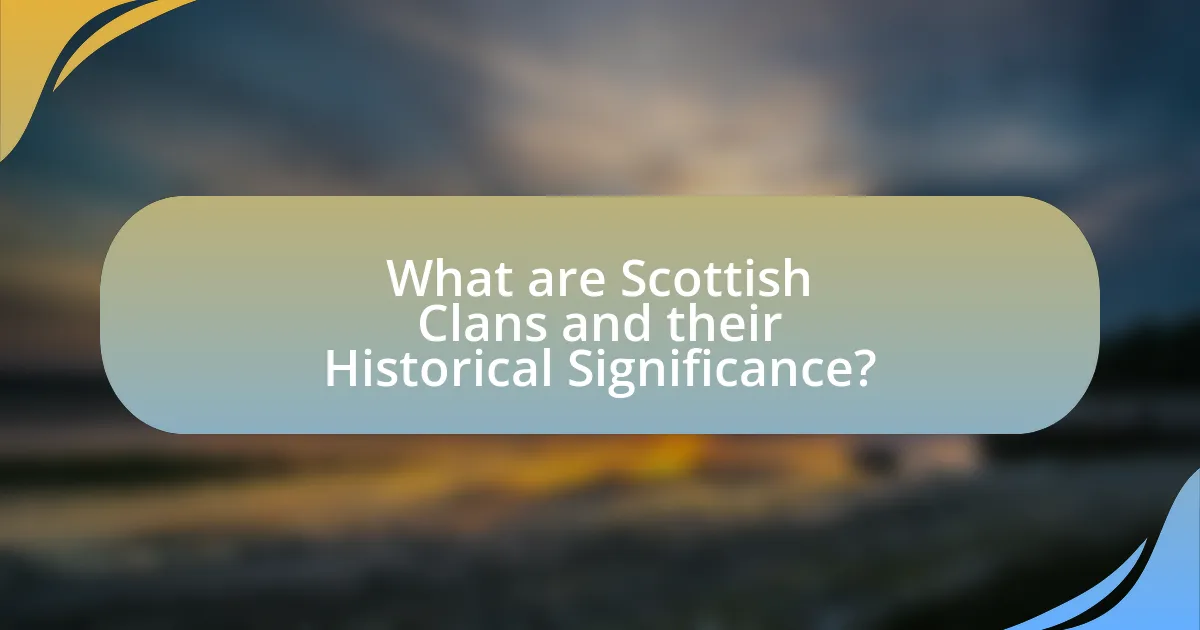
What are Scottish Clans and their Historical Significance?
Scottish clans are social groups that historically represented extended families or kinship networks in Scotland, often associated with specific territories and symbols. These clans played a crucial role in Scottish history, particularly during the Middle Ages, as they were central to the feudal system, providing military support to local lords and maintaining social order within their regions. The significance of clans is underscored by their involvement in key historical events, such as the Jacobite uprisings, where clan loyalty influenced political allegiances and conflicts. Clans also contributed to the preservation of Scottish culture, including language, traditions, and customs, which continue to be celebrated today, particularly in events like the Highland Games, where clan heritage is prominently showcased.
How did Scottish Clans form and evolve over time?
Scottish clans formed in the early medieval period as kinship groups that provided social structure and protection in a fragmented society. These clans evolved over time through a combination of territorial claims, alliances, and conflicts, often centered around a chief who held authority and land. Historical records indicate that by the 12th century, clans were well-established, with clan names often derived from geographical features or notable ancestors, reflecting their lineage and heritage. The clan system further developed during the 15th and 16th centuries, particularly after the Highland Clearances, which reshaped clan territories and dynamics, leading to a decline in traditional clan structures but a rise in cultural identity that persists today.
What were the key factors in the establishment of Scottish Clans?
The key factors in the establishment of Scottish clans included kinship ties, territorial control, and social organization. Kinship ties formed the basis of clan identity, as clans were typically composed of extended families who shared a common ancestor. Territorial control was crucial, as clans often claimed specific lands, which provided resources and a sense of belonging. Social organization within clans facilitated governance and mutual support, allowing members to defend their interests and maintain order. Historical records indicate that these factors were instrumental in shaping the clan system, particularly during the medieval period when clans became prominent in Scottish society.
How did clan rivalries shape Scottish history?
Clan rivalries significantly shaped Scottish history by influencing political alliances, social structures, and military conflicts. These rivalries often led to battles for territory and power, such as the Wars of Scottish Independence, where clans like the MacDonalds and Campbells played pivotal roles. The feuds between clans, exemplified by the infamous Campbell-MacDonald conflict, not only affected local governance but also contributed to the broader narrative of Scottish nationalism and identity. The outcomes of these rivalries often determined the allegiance of clans to the crown or to each other, impacting the course of Scottish governance and society throughout the centuries.
What role did Scottish Clans play in traditional Highland culture?
Scottish clans were central to traditional Highland culture, serving as the primary social structure that defined identity, loyalty, and community. Clans organized social life, provided mutual support, and established a sense of belonging among members, often linked by kinship and shared heritage. Historically, clans engaged in agriculture, warfare, and trade, which shaped the economic and political landscape of the Highlands. The clan system also influenced cultural practices, including music, dance, and storytelling, which were integral to Highland identity. The significance of clans is evidenced by their enduring presence in modern Highland games, where clan heritage is celebrated through competitions and gatherings, reinforcing the cultural legacy that continues to thrive today.
How did clans influence social structures in Highland communities?
Clans significantly influenced social structures in Highland communities by establishing kinship ties that dictated social organization and governance. Each clan operated as a distinct social unit, with its own leadership, customs, and laws, which fostered a sense of identity and belonging among members. This clan-based system created hierarchies where clan chiefs held authority, and loyalty to the clan was paramount, shaping community interactions and alliances. Historical evidence shows that clans played a crucial role in land ownership and resource distribution, as clan members often worked collectively for mutual benefit, reinforcing social cohesion and stability within the community.
What cultural practices are associated with Scottish Clans?
Cultural practices associated with Scottish clans include traditional music, dance, storytelling, and the wearing of clan tartans. These practices are integral to clan identity and heritage, often showcased during events like Highland Games, where clan members gather to celebrate their lineage. The use of specific tartans, which represent individual clans, is a visual symbol of clan affiliation and pride. Additionally, clan gatherings often feature traditional Scottish music played on instruments such as bagpipes, which further reinforces cultural ties. Storytelling, particularly of clan history and legends, serves to educate younger generations about their ancestry and values. These practices collectively contribute to the preservation of Scottish culture and the sense of community among clan members.
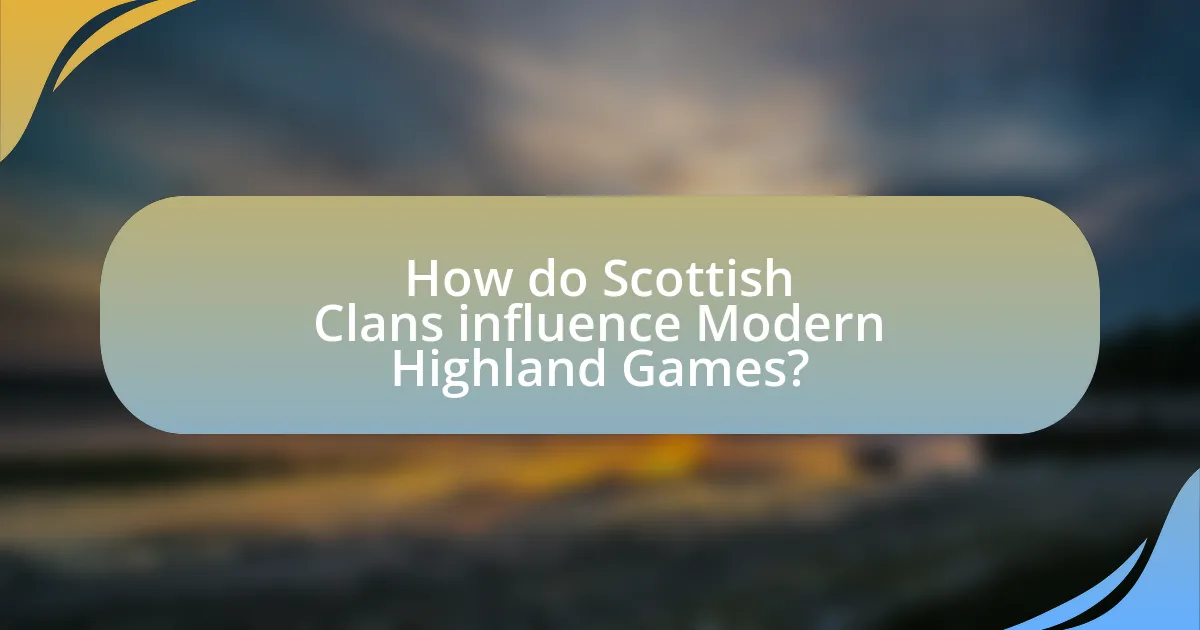
How do Scottish Clans influence Modern Highland Games?
Scottish clans significantly influence modern Highland Games by preserving traditional customs and promoting cultural identity. These clans often participate in organizing events, showcasing their unique heritage through clan tents, displays, and competitions. For instance, clan gatherings at Highland Games serve as a platform for members to celebrate their lineage, share stories, and engage in traditional sports, such as caber tossing and tug-of-war. The presence of clans enhances the authenticity of the games, as they often incorporate historical elements and rituals that reflect their ancestral practices. This connection to heritage not only attracts participants but also draws spectators interested in Scottish culture, thereby sustaining the popularity and relevance of Highland Games in contemporary society.
What are the origins of the Highland Games and their connection to clans?
The Highland Games originated in Scotland as a series of athletic competitions held to showcase strength and skill, often linked to clan gatherings. These events date back to at least the 11th century, when they were organized by Scottish kings to recruit warriors and celebrate clan loyalty. The connection to clans is significant, as the games served as a means for clans to demonstrate their prowess, unity, and cultural identity, fostering a sense of community and competition among different clans. Historical records indicate that the games evolved into a celebration of Scottish heritage, with events like caber tossing and tug-of-war reflecting both athleticism and clan pride.
How did clans contribute to the development of the Highland Games?
Clans significantly contributed to the development of the Highland Games by organizing and sponsoring events that showcased athletic prowess and cultural heritage. Historically, clans served as social and political units in Scotland, and their gatherings often included competitions in strength and skill, which evolved into the Highland Games. For instance, the MacKenzies and the Campbells were known to host games that attracted participants from various regions, fostering a sense of community and rivalry. These events not only celebrated clan identity but also preserved traditional Scottish sports, such as caber tossing and hammer throw, which became central to the modern Highland Games.
What traditional events in the Highland Games are linked to clan heritage?
Traditional events in the Highland Games that are linked to clan heritage include caber tossing, tug of war, and stone put. These events often reflect the skills and strengths valued by Scottish clans, with caber tossing symbolizing the ability to throw heavy objects, a trait admired in clan warriors. Tug of war historically represented clan unity and strength, while stone put showcases the physical prowess that clans would have relied upon in battle. The connection to clan heritage is reinforced by the fact that many Highland Games are organized by specific clans, celebrating their unique traditions and histories through these events.
In what ways do clans participate in contemporary Highland Games?
Clans participate in contemporary Highland Games primarily through organizing events, competing in traditional athletic contests, and showcasing cultural heritage. Many clans host their own Highland Games, which serve as a platform for athletic competitions such as caber tossing and tug-of-war, reflecting their historical significance. Additionally, clan members often compete in these events, representing their lineage and fostering community spirit. Cultural displays, including music, dance, and traditional dress, further enhance clan participation, allowing them to celebrate and promote their unique heritage. This involvement not only preserves Scottish traditions but also strengthens clan identity within the broader context of the Highland Games.
How do clan associations enhance the experience of the Highland Games today?
Clan associations enhance the experience of the Highland Games today by fostering a sense of community and cultural identity among participants and spectators. These associations organize events, provide resources, and promote traditional Scottish heritage, which enriches the overall atmosphere of the games. For instance, clan tents serve as gathering places where attendees can learn about their ancestry, participate in clan-specific activities, and engage with others who share similar backgrounds. This interaction not only strengthens familial bonds but also encourages the preservation of Scottish traditions, as evidenced by the increasing participation rates in clan-related events at the games, which have seen a rise of over 20% in recent years.
What role do clans play in organizing and promoting Highland Games events?
Clans play a crucial role in organizing and promoting Highland Games events by providing cultural heritage, logistical support, and community engagement. Clans often sponsor events, ensuring that traditional customs and practices are upheld, which enhances the authenticity and appeal of the games. For instance, many Highland Games are organized by local clan associations that coordinate activities, recruit participants, and manage logistics. Additionally, clans promote these events through their networks, attracting attendees and participants who are interested in Scottish culture. This involvement not only preserves the traditions associated with the Highland Games but also fosters a sense of community and belonging among participants and spectators alike.
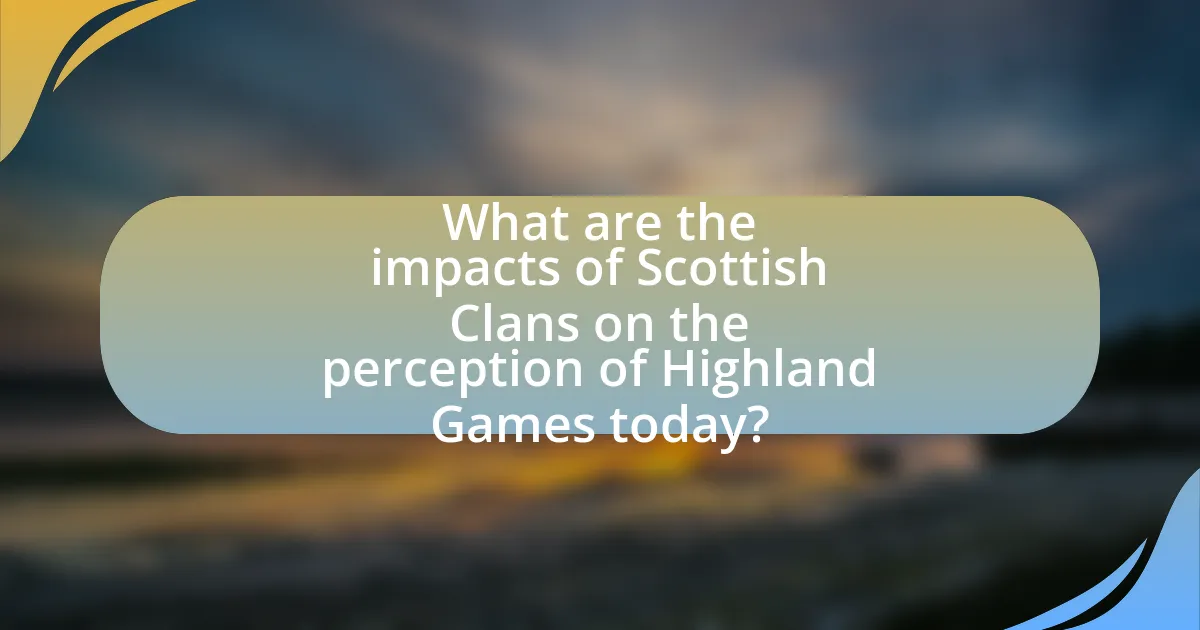
What are the impacts of Scottish Clans on the perception of Highland Games today?
Scottish clans significantly shape the perception of Highland Games today by fostering a sense of cultural identity and heritage. These clans, with their distinct tartans and traditions, create a vibrant atmosphere at the events, attracting participants and spectators who seek to connect with their ancestry. The historical significance of clans, such as the MacLeods and Campbells, enhances the authenticity of the games, making them not just athletic competitions but also celebrations of Scottish culture. This connection is evidenced by the increasing participation of clan societies in organizing and promoting Highland Games, which has led to a resurgence in interest and attendance, reflecting a broader appreciation for Scottish heritage in contemporary society.
How do clans shape the identity of participants and spectators at Highland Games?
Clans shape the identity of participants and spectators at Highland Games by fostering a sense of belonging and cultural heritage. Participants often represent their clans through traditional attire, such as kilts and clan insignia, which reinforces their connection to ancestral roots and shared history. Spectators, similarly, engage with the event by identifying with specific clans, often through family ties or regional affiliations, which enhances their experience and emotional investment in the games. The presence of clan tents and displays at these events serves as a focal point for community interaction, allowing individuals to explore their lineage and participate in clan activities, thereby solidifying their identity within the broader Scottish cultural context. This dynamic is supported by the historical significance of clans in Scotland, where clan loyalty and identity have been central to social structure and community life for centuries.
What significance do clan tartans and symbols hold during the games?
Clan tartans and symbols hold significant cultural and historical importance during the games, representing the identity and heritage of Scottish clans. Each tartan is unique to a specific clan, serving as a visual marker of lineage and tradition, which fosters a sense of belonging among participants and spectators. The display of these tartans during the Highland Games not only honors ancestral ties but also reinforces community bonds, as clans gather to celebrate their shared history and values. This practice is rooted in the 19th-century revival of Scottish culture, where tartans became emblematic of clan pride and unity, making them integral to the identity showcased at the games.
How does clan participation influence the cultural authenticity of the games?
Clan participation significantly enhances the cultural authenticity of the Highland Games by preserving traditional practices and fostering community engagement. When clans actively participate, they bring historical customs, attire, and rituals that reflect their unique heritage, which enriches the overall experience of the games. For instance, the presence of clan tents and the display of tartans not only showcase individual clan identities but also educate attendees about Scottish history and culture. This engagement is supported by the fact that events like the Clan Gathering at the Highland Games attract thousands of participants and spectators, reinforcing the cultural significance of these gatherings in maintaining Scottish traditions.
What are the future prospects for the relationship between clans and Highland Games?
The future prospects for the relationship between clans and Highland Games appear promising, as both entities continue to evolve together while preserving cultural heritage. Clans are increasingly participating in Highland Games, fostering community engagement and promoting Scottish traditions. Events like the World Highland Games Championships and local gatherings often feature clan tents and activities, enhancing visibility and participation. This collaboration not only strengthens clan identities but also attracts younger generations, ensuring the continuation of both the games and clan traditions. The increasing global interest in Scottish culture further supports this relationship, as more people seek to connect with their heritage through participation in Highland Games.
How can clans adapt to modern trends while preserving tradition in Highland Games?
Clans can adapt to modern trends while preserving tradition in Highland Games by incorporating contemporary elements such as technology and social media engagement, while maintaining traditional events and cultural practices. For instance, clans can utilize social media platforms to promote events, share stories, and connect with a younger audience, thereby increasing participation and interest. Additionally, they can introduce modern athletic categories or mixed-gender competitions to attract diverse participants, while still honoring traditional events like caber tossing and tug-of-war. This approach not only keeps the essence of the Highland Games alive but also ensures relevance in today’s society, as evidenced by the growing attendance and participation rates in events that embrace both tradition and modernity.
What strategies can clans employ to engage younger generations in Highland Games?
Clans can engage younger generations in Highland Games by incorporating modern technology and social media to promote events and activities. Utilizing platforms like Instagram and TikTok allows clans to showcase the excitement and cultural significance of the games, attracting a younger audience. Additionally, clans can organize interactive workshops and training sessions that teach traditional skills, such as caber tossing or dancing, making the experience hands-on and appealing. Research indicates that events that include youth participation, such as competitions specifically for younger athletes, can significantly increase interest and attendance among younger demographics. By blending tradition with contemporary engagement methods, clans can foster a deeper connection with the younger generation.
What are the best practices for clans to enhance their involvement in Highland Games?
Clans can enhance their involvement in Highland Games by actively participating in event organization, promoting cultural heritage, and engaging with the community. Active participation in organizing events allows clans to showcase their traditions and foster a sense of unity among members. Promoting cultural heritage through demonstrations of traditional skills, music, and dance can attract more attendees and create a vibrant atmosphere. Engaging with the community by collaborating with local businesses and schools can increase visibility and support for the games, ultimately strengthening the clan’s presence and influence. These practices are supported by the historical significance of clans in preserving Scottish culture, as evidenced by the resurgence of interest in Highland Games since the late 20th century, which has seen increased clan participation and community involvement.
